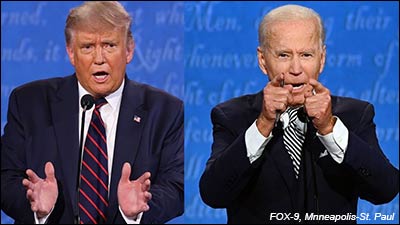By Jim Ellis

The candidates in action at the first presidential debate in Cleveland, Ohio: President Donald Trump (left) and former vice president Joe Biden.
The campaign is breaking down into two distinct issue areas for each man. President Trump wants to concentrate on rebuilding the economy and safety from the unrest in many metropolitan areas, while former vice president Joe Biden is zeroing in on healthcare, most specifically protecting the Affordable Care Act, often referred to as Obamacare, and attacking Trump over his COVID-19 record.
President Trump is attempting to rebuild his winning coalition in the battleground states that concentrated on 2016 economic issues. He did that in last night’s debate by highlighting his administration’s economic record pre-COVID and outlining how he would re-build the national economy moving forward after the related shutdown.
On law enforcement and public safety, an issue area emphasized in an attempt to re-connect with many suburban female voters who have left his coalition since the last election, Trump attacked hard. The president probably scored his strongest points of the night regarding this issue area as he pinned Biden down about the lack of law enforcement groups supporting the Democratic nominee’s candidacy.
Biden was strong in his defense of the Affordable Care Act, and again exposed the weakness in the Republican issue platform because the GOP doesn’t have an alternative plan to what currently exists. The Biden emphasis was also an attempt to target the higher educated suburban voter, and particularly the white, married female.
Additionally, the healthcare line of attack was also geared toward the base Democratic voter who depends on the ACA as their sole provider. Again illustrating that these individuals would lose their healthcare coverage if the Supreme Court were to declare the program as unconstitutional very likely scored political points for Biden within his targeted constituency groups.
In the closing section of the debate, President Trump used his time on the issue of mail voting to express his concerns about ballot security and the length of the post-election period that we will see in many states. Expecting political overtime to last “weeks, if not months,” Trump reiterated that concerns exist about whether we will have a verified election, while citing the many states that experienced problems during the primary season.
The president’s move here was not so much aimed at a particular constituency, but perhaps directly toward election officials such as Pennsylvania Secretary of State Kathy Boockvar who has issued an order prohibiting county clerks from comparing a person’s signature on the absentee ballot to their individual voter registration card. No other state official has taken the mail vote procedure as far. Knowing that the Keystone State could again be determinative in deciding the national election, the president is pulling out all the stops to draw national attention to this potential chaotic post-election situation.
One issue not addressed, and curiously so from President Trump’s perspective, was the area of gun control, or 2nd Amendment protection, during the free discussion period. The issue also appeared surprisingly absent in US Senate debates from places like Iowa and Montana in debates that occurred over the weekend.
Polling has proven that the gun issue is probably the top driver of low propensity right-of-center voters, which will be key for Trump and the Republican Senate candidates in several battleground states. This appears to be a missed opportunity especially in light of the Supreme Court vacancy and the upcoming confirmation process in which this issue could directly relate.
The next forum features the vice presidential candidates, incumbent Mike Pence and Sen. Kamala Harris (D-CA), and will occur in Salt Lake City on Oct. 7. The succeeding presidential debate will be a town hall format from Miami on Oct. 15, followed by the Oct. 22 finale in Nashville featuring the same format we saw last night.
It remains to be seen what, if any, effect last night’s debate had on battleground state polling and whether the issue matrix will influence actual voting within the next month.
